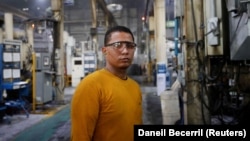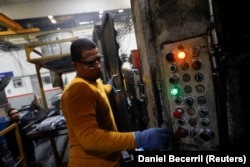Walter Banegas is a refugee from the Central American country of Honduras. He now lives in the northern Mexican city of Saltillo. There, he works in a factory, making aluminum parts for machines.
But Mexico is not the first country Banegas, 28, has tried to call home. To avoid violent drug gangs in Honduras, he first fled to the United States as a teenager. But he was deported in 2014. Hoping to seek asylum, he re-entered the U.S. in 2020, only to be deported once again.
So when Banegas fled Honduras once more in 2021, he aimed for Mexico instead of the U.S. He was granted refugee status and with help from a United Nations refugee program, moved to Saltillo. There, he was connected to a job at Pace Industries, a U.S.-based metal manufacturer with plants in the U.S. and Mexico.
In the last five years, Mexico has seen an increase in the number of refugees choosing to stay in the country. There, the asylum system is less strict than in the U.S., and refugees can find jobs because companies in Mexico need more workers.
Banegas said he is earning about $800 a month at Pace Industries. This is less than he thought he would make in the U.S. But it is enough to send at least $50 a month home to his family. He says he likes his Mexican co-workers and is proud his six-month-old son, David, is a Mexican citizen.
"I feel at peace here," he said. "It's not necessary to go to the United States. You can also get ahead here, in Mexico."
A good choice for some refugees
About ten years ago, only a few hundred people received asylum in Mexico each year. By 2021, the number rose to 27,000, according to Mexico's refugee agency. Mexico will likely approve at least 20,000 asylum cases this year, with most of the arrivals coming from Honduras, Haiti, Venezuela, El Salvador and Cuba.
A large majority of migrants entering Mexico continue north toward the U.S. The U.S. had more than 700,000 individual asylum claims last year.
But the head of the U.N. refugee agency (UNHCR) in Mexico, Giovanni Lepri, said Mexico is becoming a good choice for refugees, in part because of its high need for workers.
Coparmex studies Mexico’s economy and social issues. The organization says Mexico has more than one million job openings nationwide. In a recent study of more than 2,500 businesses in Mexico, it says 85 percent of employers in manufacturing report trouble finding workers, more than in any other employment area.
U.S., Mexican and U.N. officials have called for cooperation to help migrants resettle in places such as Mexico, Costa Rica and Colombia, aiming to reduce illegal migration to the U.S.
Arturo Rocha is the migration director for Mexico's foreign ministry. He said the government is trying to expand work visa programs and connect employers with migrants looking for jobs.
Mexico is working with Guatemala's government to bring up to 20,000 workers to Mexico each year. Mexico also aims to expand the program to Honduras and El Salvador.
Jose Medina Mora, the head of Coparmex, praised the U.N. program that helped Banegas relocate to Saltillo. He also urged the Mexican government to expand work visa programs so more migrants can be quickly matched with employers.
The U.N. program helps refugees relocate from southern Mexico, where most complete their asylum process, to cities in central and northern Mexico. The program gives money and helps with finding jobs. It also helps refugees find childcare, schools and healthcare. It helped connect 5,500 refugees with a job in 2022, and nearly 3,000 so far this year.
“Couldn’t ask for more”
Fernando Hernandez, 24, fled Honduras for southern Mexico last year with his partner and young daughter. He planned to cross the country as quickly as possible to reach the U.S.
But then he saw social media posts of children drowning in the river at the U.S. border. He imagined his two-year-old daughter also dying in the water. And he thought about his mother, who migrated to the U.S. in 2017. She lives in a small mobile home in the state of Texas and uses most of her pay for housing.
So, Hernandez decided to seek asylum in Mexico. After it was approved in February, the U.N. helped his family relocate to the northern industrial city of Monterrey. There, Hernandez began working at a small store that sells food, drink, and other things people need.
Hernandez quickly learned that there were job openings everywhere, he said. He got a job in a factory, and then became a cook at P.F. Chang's, earning about $225 a week.
"Here we have everything: a house, food and family," he said. "I couldn't ask for more."
I’m Andrew Smith. And I'm Anna Mateo.
Laura Gottesdiener and Daina Beth Solomon wrote this story for Reuters News. Andrew Smith adapted it for VOA Learning English.
__________________________________________________
Words in This Story
gang -n. a group of criminals who work together to commit crimes
teenager -n. a young person between 13 and 19 years old
relocate -v. to move to a different city or country
match -v. to connect with another in a way that works well












Forum